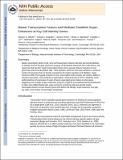| dc.contributor.author | Whyte, Warren A. | |
| dc.contributor.author | Orlando, David A. | |
| dc.contributor.author | Hnisz, Denes | |
| dc.contributor.author | Abraham, Brian J. | |
| dc.contributor.author | Lin, Charles Y. | |
| dc.contributor.author | Kagey, Michael H. | |
| dc.contributor.author | Rahl, Peter B. | |
| dc.contributor.author | Lee, Tong Ihn | |
| dc.contributor.author | Young, Richard A. | |
| dc.contributor.author | Young, Richard A. | |
| dc.date.accessioned | 2016-08-11T15:32:10Z | |
| dc.date.available | 2016-08-11T15:32:10Z | |
| dc.date.issued | 2013-04 | |
| dc.date.submitted | 2013-02 | |
| dc.identifier.issn | 00928674 | |
| dc.identifier.uri | http://hdl.handle.net/1721.1/103896 | |
| dc.description.abstract | Master transcription factors Oct4, Sox2, and Nanog bind enhancer elements and recruit Mediator to activate much of the gene expression program of pluripotent embryonic stem cells (ESCs). We report here that the ESC master transcription factors form unusual enhancer domains at most genes that control the pluripotent state. These domains, which we call super-enhancers, consist of clusters of enhancers that are densely occupied by the master regulators and Mediator. Super-enhancers differ from typical enhancers in size, transcription factor density and content, ability to activate transcription, and sensitivity to perturbation. Reduced levels of Oct4 or Mediator cause preferential loss of expression of super-enhancer-associated genes relative to other genes, suggesting how changes in gene expression programs might be accomplished during development. In other more differentiated cells, super-enhancers containing cell-type-specific master transcription factors are also found at genes that define cell identity. Super-enhancers thus play key roles in the control of mammalian cell identity. | en_US |
| dc.description.sponsorship | National Institutes of Health (U.S.) (NIH grant HG002668) | en_US |
| dc.description.sponsorship | National Institutes of Health (U.S.) (NIH grant CA146445) | en_US |
| dc.language.iso | en_US | |
| dc.publisher | Elsevier | en_US |
| dc.relation.isversionof | http://dx.doi.org/10.1016/j.cell.2013.03.035 | en_US |
| dc.rights | Creative Commons Attribution-NonCommercial-NoDerivs License | en_US |
| dc.rights.uri | http://creativecommons.org/licenses/by-nc-nd/4.0/ | en_US |
| dc.source | PMC | en_US |
| dc.title | Master Transcription Factors and Mediator Establish Super-Enhancers at Key Cell Identity Genes | en_US |
| dc.type | Article | en_US |
| dc.identifier.citation | Whyte, Warren A., David A. Orlando, Denes Hnisz, Brian J. Abraham, Charles Y. Lin, Michael H. Kagey, Peter B. Rahl, Tong Ihn Lee, and Richard A. Young. “Master Transcription Factors and Mediator Establish Super-Enhancers at Key Cell Identity Genes.” Cell 153, no. 2 (April 2013): 307–319. | en_US |
| dc.contributor.department | Massachusetts Institute of Technology. Department of Biology | en_US |
| dc.contributor.department | Whitehead Institute for Biomedical Research | en_US |
| dc.contributor.mitauthor | Young, Richard A. | en_US |
| dc.relation.journal | Cell | en_US |
| dc.eprint.version | Author's final manuscript | en_US |
| dc.type.uri | http://purl.org/eprint/type/JournalArticle | en_US |
| eprint.status | http://purl.org/eprint/status/PeerReviewed | en_US |
| dspace.orderedauthors | Whyte, Warren A.; Orlando, David A.; Hnisz, Denes; Abraham, Brian J.; Lin, Charles Y.; Kagey, Michael H.; Rahl, Peter B.; Lee, Tong Ihn; Young, Richard A. | en_US |
| dspace.embargo.terms | N | en_US |
| dc.identifier.orcid | https://orcid.org/0000-0001-8855-8647 | |
| mit.license | PUBLISHER_CC | en_US |
